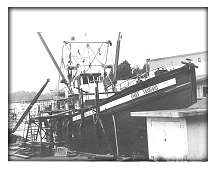

| Vol. 1 - No. 1 | EST 1997 | Winter 1997 |
Page 1 - Page 2 - Page 3 - Page 4 | Back |
Henry Reid - Bull Of The Skeena
They called him the "Bull of the Skeena." When the Grand Trunk Pacific drove a railway into northern B.C., Henry Reid was already a fourth-generation resident; and whenever conversation turns to the Skeena River, his name is always mentioned.

Henry Reid spent much of his boyhood in Port Simpson. "When my mother would go out to the canneries," he said, "I had to live with my grandmother." Before long Reid was himself at the canneries. "I'd go down to the cannery... get ten cents an hour to work at Cassiar Cannery! Throwin' fish on the table for the Chinamen to behead; we had no Iron Chink them days. Then I jumped the boat, I wasn't quite 16, went to Vancouver and I worked on the Venture nine months, Queen City, tug Dola, tug Bell, Morning Star, fished herring for a dollar and ten cents a ton, fished dog salmon for twenty-five cents apiece."
Reid returned to the Skeena in about 1920 and married. The young couple spent a winter in Port Simpson, then worked at Haysport before moving into a"cannery shack" at Port Essington. Reid was working on sail gillnetters on the river: "We slept alongside the mast, one guy on each side, no mattress, right bare on hard boards. Only thing you'd kick off was your gumboots." Still, he found this life better than working as deckhand on the larger boats: "You were free and easy; you're your own boss. Nobody lookin' down your collar."
"And I got ahead in Essington," he added, "I bought a home for 250 dollars. Seven room house... Put new foundation on myself." Reid chuckled at the memory, adding: "That's where my daughter learned to swear." Reid told stones of the legendary characters who built Port Essington. What he had not seen himself, he knew from the stones of his friends and his wife's family. As one example, when asked about the notorious 1926 murder of Loretta Chisholm, Reid gave the story simple credibility by beginning: 'I was there... I helped pack her out."
Reid's life's work included many twists and turns, but he was first, Iast and always a Skeena River fisherman. He landed fish for many of the Skeena canneries. Of course, the sail gillnetter didn't last for long. He soon bought a twenty-five-dollar, square-sterned Norcap gasboat from his father-in-law.
Reid's role at Port Essington expanded in the 1930s. ''I knew Stewart Donaldson well," Reid explained. "I used to work with him on the Two Rivers goin' across the river with the mail, and then when he gave up the mail contract he turned it over to me. He had two years more of his contract to finish. and that was 1936." Although Reid gave up the mail contract more than once, there was quite simply no-one else who would commit to the job. "I took it over because I wanted to keep that mail going, you see," he explained. His daughter ran the post office under his name, and he shuttled the mail back and forth from Haysport.
Reid's small gasboat was by now long gone. I had a Chrysler built in Steveston," he said. "Then I had a little packer, the Wilmar it was 36 feet long. That's the one I used for mail, gunwood on the outside." In the late 1950s Reid moved into Prince Rupert, but his connection to Port Essington remained strong. He was still Essington's road superintendent, and rebuilt the roads after the 1961 fire.
Reid's final boat was the Silver Mist built by Ed Wall at Dodge Cove. "I sold my boat before the price of the licence went up. I lost money. I sold my boat for a thousand. And if I d waited another year I'd have got twenty thousand. The price of fishin' licence went up, you know... People went crazy for awhile here. "But I [still] went fishing. I had nets there; I went fishin' for other guys. I went fishin'. showed them the river. showed them how to fish the river.
It was a fitting conclusion for the career of one of the Skeena River's best-remembered personalities.Designed by: Prince Rupert Public Library
| PRL Internet Home | Questions/Comments |
© Prince Rupert Public Library
Updated on: Feb. 28th 1998.